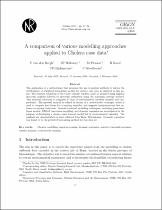JavaScript is disabled for your browser. Some features of this site may not work without it.
- ResearchSpace
- →
- Research Publications/Outputs
- →
- Journal Articles
- →
- View Item
| dc.contributor.author |
Van Den Bergh, F

|
|
| dc.contributor.author |
Holloway, Jennifer P

|
|
| dc.contributor.author |
Pienaar, M

|
|
| dc.contributor.author |
Koen, Renée

|
|
| dc.contributor.author |
Elphinstone, CD

|
|
| dc.contributor.author |
Woodborne, S

|
|
| dc.date.accessioned | 2008-12-17T13:35:46Z | |
| dc.date.available | 2008-12-17T13:35:46Z | |
| dc.date.issued | 2008-06 | |
| dc.identifier.citation | Van Den Bergh, F, Holloway, JP et al. 2008. Comparison of various modelling approaches applied to cholera case data. Orion: Journal of the Operations Research Society of South Africa, Vol 24(1), pp 17-36 | en |
| dc.identifier.issn | 0529-191-X | |
| dc.identifier.uri | http://www.ajol.info/viewarticle.php?jid=239&id=36998&layout=abstract | |
| dc.identifier.uri | http://hdl.handle.net/10204/2762 | |
| dc.description | Copyright: 2008 Operations Research Society of South Africa (ORSSA) | en |
| dc.description.abstract | The application of a methodology that proposes the use of spectral methods to inform the development of statistical forecasting models for cholera case data is explored in this paper. The seasonal behaviour of the target variable (cholera cases) is analysed using singular spectrum analysis followed by spectrum estimation using the maximum entropy method. This seasonal behaviour is compared to that of environmental variables (rainfall and temperature). The spectral analysis is re ned by means of a cross-wavelet technique, which is used to compute lead times for co-varying variables, and suggests transformations that enhance co-varying behaviour. Several statistical modelling techniques, including generalised linear models, ARIMA time series modelling, and dynamic regression are investigated for the purpose of developing a cholera cases forecast model fed by environmental variables. The analyses are demonstrated on data collected from Beira, Mozambique. Dynamic regression was found to be the preferred forecasting method for this data set | en |
| dc.language.iso | en | en |
| dc.subject | Cholera | en |
| dc.subject | Modelling | en |
| dc.subject | Signal processing | en |
| dc.subject | Dynamic regression | en |
| dc.subject | Negative binomial regression | en |
| dc.subject | Cross-wavelet analysis | en |
| dc.subject | Wavelet analysis | en |
| dc.title | Comparison of various modelling approaches applied to cholera case data | en |
| dc.type | Article | en |
| dc.identifier.apacitation | Van Den Bergh, F., Holloway, J. P., Pienaar, M., Koen, R., Elphinstone, C., & Woodborne, S. (2008). Comparison of various modelling approaches applied to cholera case data. http://hdl.handle.net/10204/2762 | en_ZA |
| dc.identifier.chicagocitation | Van Den Bergh, F, Jennifer P Holloway, M Pienaar, Renée Koen, CD Elphinstone, and S Woodborne "Comparison of various modelling approaches applied to cholera case data." (2008) http://hdl.handle.net/10204/2762 | en_ZA |
| dc.identifier.vancouvercitation | Van Den Bergh F, Holloway JP, Pienaar M, Koen R, Elphinstone C, Woodborne S. Comparison of various modelling approaches applied to cholera case data. 2008; http://hdl.handle.net/10204/2762. | en_ZA |
| dc.identifier.ris | TY - Article AU - Van Den Bergh, F AU - Holloway, Jennifer P AU - Pienaar, M AU - Koen, Renée AU - Elphinstone, CD AU - Woodborne, S AB - The application of a methodology that proposes the use of spectral methods to inform the development of statistical forecasting models for cholera case data is explored in this paper. The seasonal behaviour of the target variable (cholera cases) is analysed using singular spectrum analysis followed by spectrum estimation using the maximum entropy method. This seasonal behaviour is compared to that of environmental variables (rainfall and temperature). The spectral analysis is re ned by means of a cross-wavelet technique, which is used to compute lead times for co-varying variables, and suggests transformations that enhance co-varying behaviour. Several statistical modelling techniques, including generalised linear models, ARIMA time series modelling, and dynamic regression are investigated for the purpose of developing a cholera cases forecast model fed by environmental variables. The analyses are demonstrated on data collected from Beira, Mozambique. Dynamic regression was found to be the preferred forecasting method for this data set DA - 2008-06 DB - ResearchSpace DP - CSIR KW - Cholera KW - Modelling KW - Signal processing KW - Dynamic regression KW - Negative binomial regression KW - Cross-wavelet analysis KW - Wavelet analysis LK - https://researchspace.csir.co.za PY - 2008 SM - 0529-191-X T1 - Comparison of various modelling approaches applied to cholera case data TI - Comparison of various modelling approaches applied to cholera case data UR - http://hdl.handle.net/10204/2762 ER - | en_ZA |






